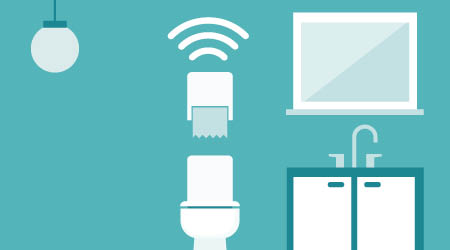
Imagine, as a facility cleaning manager, having the ability to head off restroom complaints before they ever happen.
Well, imagine no further: A wide variety of Internet of Things, or IoT, solutions are becoming increasingly available that allow facility cleaning managers to tap into restroom fixtures and dispensers, which inform them of high usage, low supplies or even the possibility of future malfunctions. This technology can alert managers of a problem well before a restroom patron notices, which can help departments improve tenant satisfaction and avoid cleaning complaints.
“Those kinds of complaints that come from the restroom are generally the worst possible complaints. … Those are things that really upset people,” says Terry Sanchez, a sales and marketing representative at Kimberly-Clark Professional, Roswell, Georgia. “If facility managers are able to know that the problem is there before [the complaint] happens … they would be able to handle the issue before the building occupant reaches out with the problem.”
IoT allows for the aggregation of data through the connectivity of objects to the Internet. The most common examples are currently in consumer products, such as fitness watches, home thermostats and smart televisions.
But the technology has now reached the restroom, allowing for the tracking and monitoring of a whole host of usage data points. These data points include the amount of product remaining in a dispenser and the usage of each restroom visitor. Data points can also be correlated to determine the times of highest restroom usage, and the relationship between the usage of different dispensers and even different locations.
In addition, many of the restroom IoT solutions on the market give the facility cleaning manager a dashboard view via a tablet or computer on which they can see the specific issue with a restroom dispenser rather than aimlessly troubleshooting a problem, which can cost time and money. For instance, a complaint may suggest that a dispenser is broken, when in fact it just needs its batteries replaced or a jam to be fixed. Knowing the problem beforehand saves the frontline cleaner trips back and forth to the restroom and decreases the likelihood that the department will replace the dispenser when a less expensive solution could have solved the problem.
“There is an unbelievable amount of information that would be available to the facility manager just by looking at their phone or laptop,” says Sanchez. “Information is knowledge and knowledge is power.”
Using IoT To Solve Restroom Problems

 The Down and Dirty on Cleaning in Virus Season
The Down and Dirty on Cleaning in Virus Season How Surfactant Use is Expanding in Commercial Cleaning
How Surfactant Use is Expanding in Commercial Cleaning Operational Excellence Series 2025: Labor Strategies
Operational Excellence Series 2025: Labor Strategies
